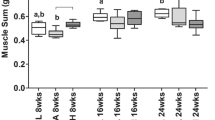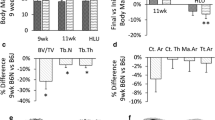Abstract
Summary
How cortical and trabecular bone co-develop to establish a mechanically functional structure is not well understood. Comparing early postnatal differences in morphology of lumbar vertebral bodies for three inbred mouse strains identified coordinated changes within and between cortical and trabecular traits. These early coordinate changes defined the phenotypic differences among the inbred mouse strains.
Introduction
Age-related changes in cortical and trabecular traits have been well studied; however, very little is known about how these bone tissues co-develop from day 1 of postnatal growth to establish functional structures by adulthood. In this study, we aimed to establish how cortical and trabecular tissues within the lumbar vertebral body change during growth for three inbred mouse strains that express wide variation in adult bone structure and function.
Methods
Bone traits were quantified for lumbar vertebral bodies of female A/J, C57BL/6J (B6), and C3H/HeJ (C3H) inbred mouse strains from 1 to 105 days of age (n = 6–10 mice/age/strain).
Results
Inter-strain differences in external bone size were observed as early as 1 day of age. Reciprocal and rapid changes in the trabecular bone volume fraction and alignment in the direction of axial compression were observed by 7 days of age. Importantly, the inter-strain difference in adult trabecular bone volume fraction was established by 7 days of age. Early variation in external bone size and trabecular architecture was followed by progressive increases in cortical area between 28 and 105 days of age, with the greatest increases in cortical area seen in the mouse strain with the lowest trabecular mass.
Conclusion
Establishing the temporal changes in bone morphology for three inbred mouse strains revealed that genetic variation in adult trabecular traits were established early in postnatal development. Early variation in trabecular architecture preceded strain-specific increases in cortical area and changes in cortical thickness. This study established the sequence of how cortical and trabecular traits co-develop during growth, which is important for identifying critical early ages to further focus on intervention studies that optimize adult bone strength.





Similar content being viewed by others
References
Cosman F, de Beur SJ, LeBoff MS, Lewiecki EM, Tanner B, Randall S, Lindsay R (2014) Clinician’s guide to prevention and treatment of osteoporosis. Osteoporos Int 25:2359–2381
Gourlay ML, Brown SA (2004) Clinical considerations in premenopausal osteoporosis. Arch Intern Med 164:603–614
Bala Y, Bui QM, Wang XF, Iuliano S, Wang Q, Ghasem-Zadeh A, Rozental TD, Bouxsein ML, Zebaze RM, Seeman E (2015) Trabecular and cortical microstructure and fragility of the distal radius in women. J Bone Miner Res 30:621–629
Duan Y, Turner CH, Kim BT, Seeman E (2001) Sexual dimorphism in vertebral fragility is more the result of gender differences in age-related bone gain than bone loss. J Bone Miner Res 16:2267–2275
Tommasini SM, Nasser P, Hu B, Jepsen KJ (2008) Biological co-adaptation of morphological and composition traits contributes to mechanical functionality and skeletal fragility. J Bone Miner Res 23:236–246
Jepsen KJ, Courtland HW, Nadeau JH (2010) Genetically determined phenotype covariation networks control bone strength. J Bone Miner Res 25:1581–1593
Shanbhogue VV, Brixen K, Hansen S (2016) Age- and sex-related changes in bone microarchitecture and estimated strength: a three-year prospective study using HR-pQCT. J Bone Miner Res 31:1541–1549
Christiansen BA, Kopperdahl DL, Kiel DP, Keaveny TM, Bouxsein ML (2011) Mechanical contributions of the cortical and trabecular compartments contribute to differences in age-related changes in vertebral body strength in men and women assessed by QCT-based finite element analysis. J Bone Miner Res 26:974–983
Silva MJ, Keaveny TM, Hayes WC (1997) Load sharing between the shell and centrum in the lumbar vertebral body. Spine (Phila Pa 1976) 22:140–150
Akhter MP, Iwaniec UT, Covey MA, Cullen DM, Kimmel DB, Recker RR (2000) Genetic variations in bone density, histomorphometry, and strength in mice. Calcif Tissue Int 67:337–344
Akhter MP, Otero JK, Iwaniec UT, Cullen DM, Haynatzki GR, Recker RR (2004) Differences in vertebral structure and strength of inbred female mouse strains. J Musculoskelet Neuronal Interact 4:33–40
Tommasini SM, Hu B, Nadeau JH, Jepsen KJ (2009) Phenotypic integration among trabecular and cortical bone traits establishes mechanical functionality of inbred mouse vertebrae. J Bone Miner Res 24:606–620
Courtland HW, Spevak M, Boskey AL, Jepsen KJ (2009) Genetic variation in mouse femoral tissue-level mineral content underlies differences in whole bone mechanical properties. Cells Tissues Organs 189:237–240
Tommasini SM, Morgan TG, van der Meulen M, Jepsen KJ (2005) Genetic variation in structure-function relationships for the inbred mouse lumbar vertebral body. J Bone Miner Res 20:817–827
Zebaze RM, Jones A, Knackstedt M, Maalouf G, Seeman E (2007) Construction of the femoral neck during growth determines its strength in old age. J Bone Miner Res 22:1055–1061
Epelboym Y, Gendron RN, Mayer J, Fusco J, Nasser P, Gross G, Ghillani R, Jepsen KJ (2012) The interindividual variation in femoral neck width is associated with the acquisition of predictable sets of morphological and tissue-quality traits and differential bone loss patterns. J Bone Miner Res 27:1501–1510
Marshall LM, Lang TF, Lambert LC, Zmuda JM, Ensrud KE, Orwoll ES (2006) Dimensions and volumetric BMD of the proximal femur and their relation to age among older U.S. men. J Bone Miner Res 21:1197–1206
Buie HR, Moore CP, Boyd SK (2008) Postpubertal architectural developmental patterns differ between the L3 vertebra and proximal tibia in three inbred strains of mice. J Bone Miner Res 23:2048–2059
Glatt V, Canalis E, Stadmeyer L, Bouxsein ML (2007) Age-related changes in trabecular architecture differ in female and male C57BL/6J mice. J Bone Miner Res 22:1197–1207
Tanck E, Homminga J, van Lenthe GH, Huiskes R (2001) Increase in bone volume fraction precedes architectural adaptation in growing bone. Bone 28:650–654
Roschger P, Grabner BM, Rinnerthaler S, Tesch W, Kneissel M, Berzlanovich A, Klaushofer K, Fratzl P (2001) Structural development of the mineralized tissue in the human L4 vertebral body. J Struct Biol 136:126–136
Jepsen KJ, Silva MJ, Vashishth D, Guo XE, van der Meulen MC (2015) Establishing biomechanical mechanisms in mouse models: practical guidelines for systematically evaluating phenotypic changes in the diaphyses of long bones. J Bone Miner Res 30:951–966
Courtland HW, Nasser P, Goldstone AB, Spevak L, Boskey AL, Jepsen KJ (2008) Fourier transform infrared imaging microspectroscopy and tissue-level mechanical testing reveal intraspecies variation in mouse bone mineral and matrix composition. Calcif Tissue Int 83:342–353
Price C, Herman BC, Lufkin T, Goldman HM, Jepsen KJ (2005) Genetic variation in bone growth patterns defines adult mouse bone fragility. J Bone Miner Res 20:1983–1991
Fox WM (1965) Reflex-ontogeny and behavioural development of the mouse. Anim Behav 13:234–241
Turner CH, Hsieh YF, Muller R, Bouxsein ML, Rosen CJ, McCrann ME, Donahue LR, Beamer WG (2001) Variation in bone biomechanical properties, microstructure, and density in BXH recombinant inbred mice. J Bone Miner Res 16:206–213
Borm GF, Fransen J, Lemmens WAJG (2007) A simple sample size formula for analysis of covariance in randomized clinical trials. J Clin Epidemiol 60:1234–1238
Parfitt AM, Mathews CH, Villanueva AR, Kleerekoper M, Frame B, Rao DS (1983) Relationships between surface, volume, and thickness of iliac trabecular bone in aging and in osteoporosis: implications for the microanatomic and cellular mechanisms of bone loss. J Clin Invest 72:1396–1409
Doube M, Klosowski MM, Arganda-Carreras I, Cordelieres FP, Dougherty RP, Jackson JS, Schmid B, Hutchinson JR, Shefelbine SJ (2010) BoneJ: free and extensible bone image analysis in ImageJ. Bone 47:1076–1079
Odgaard A (1997) Three-dimensional methods for quantification of cancellous bone architecture. Bone 20:315–328
Harrigan TP, Mann RW (1984) Characterization of microstructural anisotropy in orthotropic materials using a second rank tensor. J Mater Sci 19:761–767
Ott SM (2008) Histomorphometric measurements of bone turnover, mineralization, and volume. Clin J Am Soc Nephrol 3(Suppl 3):S151–S156
Dempster DW, Compston JE, Drezner MK, Glorieux FH, Kanis JA, Malluche H, Meunier PJ, Ott SM, Recker RR, Parfitt AM (2013) Standardized nomenclature, symbols, and units for bone histomorphometry: a 2012 update of the report of the ASBMR Histomorphometry Nomenclature Committee. J Bone Miner Res 28:2–17
Gerstenfeld LC, McLean J, Healey DS, Stapleton SN, Silkman LJ, Price C, Jepsen KJ (2010) Genetic variation in the structural pattern of osteoclast activity during post-natal growth of mouse femora. Bone 46:1546–1554
Byers S, Moore AJ, Byard RW, Fazzalari NL (2000) Quantitative histomorphometric analysis of the human growth plate from birth to adolescence. Bone 27:495–501
Fazzalari NL, Moore AJ, Byers S, Byard RW (1997) Quantitative analysis of trabecular morphogenesis in the human costochondral junction during the postnatal period in normal subjects. Anat Rec 248:1–12
Wang Q, Ghasem-Zadeh A, Wang XF, Iuliano-Burns S, Seeman E (2011) Trabecular bone of growth plate origin influences both trabecular and cortical morphology in adulthood. J Bone Miner Res 26:1577–1583
Cadet ER, Gafni RI, McCarthy EF, McCray DR, Bacher JD, Barnes KM, Baron J (2003) Mechanisms responsible for longitudinal growth of the cortex: coalescence of trabecular bone into cortical bone. J Bone Joint Surg Am 85-A:1739–1748
Tanck E, Hannink G, Ruimerman R, Buma P, Burger EH, Huiskes R (2006) Cortical bone development under the growth plate is regulated by mechanical load transfer. J Anat 208:73–79
Jepsen KJ, Hu B, Tommasini SM, Courtland HW, Price C, Cordova M, Nadeau JH (2009) Phenotypic integration of skeletal traits during growth buffers genetic variants affecting the slenderness of femora in inbred mouse strains. Mamm Genome 20:21–33
Cheverud JM (1982) Phenotypic, genetic, and environmental morphological integration in the cranium JSTOR. Evolution 36:499–516
Khoury BM, Bigelow EMR, Smith LM, Schlecht SH, Scheller EL, Andarawis-Puri N, Jepsen KJ (2015) The use of nano-computed tomography to enhance musculoskeletal research. Connect Tissue Res 56:106–119
Slyfield CR, Tkachenko EV, Wilson DL, Hernandez CJ (2012) Three-dimensional dynamic bone histomorphometry. J Bone Miner Res 27:486–495
Ruff C (2005) Growth tracking of femoral and humeral strength from infancy through late adolescence. Acta Paediatr 94:1030–1037
Acknowledgments
We thank the National Institute of Health, National Institute of Arthritis and Musculoskeletal and Skin Diseases (AR056639, AR44927), for the support of this research. The content is solely the responsibility of the authors and does not necessarily represent the official views of the National Institute of Health.
Author information
Authors and Affiliations
Corresponding author
Ethics declarations
Conflicts of interest
None.
Electronic supplementary material
Below is the link to the electronic supplementary material.
ESM 1
(DOCX 35 kb)
Supplemental Figure 1
Representative mid cross-sectional images of a mouse lumbar vertebrae indicating analysis of cortical and trabecular traits in the vertebral body. In the (A) mid-transverse plane, the outermost outline indicates cross-sectional total area (Tt.Ar). Cortical area (Ct.Ar) was calculated as Tt.Ar – Med.Ar (medullary area), where Med.Ar = marrow area + trabecular bone area. In the (B) mid-coronal plane, the outline indicates the area of interest between cranial and caudal growth plates used to determine the percentage of trabecular bone area (%Tb.Ar) and the average trabecular thickness (Tb.Th). (GIF 115 kb)
Rights and permissions
About this article
Cite this article
Ramcharan, M.A., Faillace, M.E., Guengerich, Z. et al. The development of inter-strain variation in cortical and trabecular traits during growth of the mouse lumbar vertebral body. Osteoporos Int 28, 1133–1143 (2017). https://doi.org/10.1007/s00198-016-3801-6
Received:
Accepted:
Published:
Issue Date:
DOI: https://doi.org/10.1007/s00198-016-3801-6




